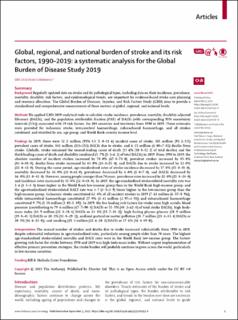Global, regional, and national burden of stroke and its risk factors, 1990–2019: a systematic analysis for the Global Burden of Disease Study 2019
Feigin, Valery L.; Stark, Benjamin A; Owens Johnson, Catherine; Roth, Gregory A.; Bisignano, Catherine; Kisa, Adnan; Stroke Collaborators, GBD 2019; Kisa, Sezer; Zhong, Chenwen; Zuniga, Yves Miel H; Murray, Christopher J L
Peer reviewed, Journal article
Published version
Date
2021-09-03Metadata
Show full item recordCollections
Abstract
Background: Regularly updated data on stroke and its pathological types, including data on their incidence, prevalence, mortality, disability, risk factors, and epidemiological trends, are important for evidence-based stroke care planning and resource allocation. The Global Burden of Diseases, Injuries, and Risk Factors Study (GBD) aims to provide a standardised and comprehensive measurement of these metrics at global, regional, and national levels. Methods: We applied GBD 2019 analytical tools to calculate stroke incidence, prevalence, mortality, disability-adjusted life-years (DALYs), and the population attributable fraction (PAF) of DALYs (with corresponding 95% uncertainty intervals [UIs]) associated with 19 risk factors, for 204 countries and territories from 1990 to 2019. These estimates were provided for ischaemic stroke, intracerebral haemorrhage, subarachnoid haemorrhage, and all strokes combined, and stratified by sex, age group, and World Bank country income level. Findings: In 2019, there were 12·2 million (95% UI 11·0–13·6) incident cases of stroke, 101 million (93·2–111) prevalent cases of stroke, 143 million (133–153) DALYs due to stroke, and 6·55 million (6·00–7·02) deaths from stroke. Globally, stroke remained the second-leading cause of death (11·6% [10·8–12·2] of total deaths) and the third-leading cause of death and disability combined (5·7% [5·1–6·2] of total DALYs) in 2019. From 1990 to 2019, the absolute number of incident strokes increased by 70·0% (67·0–73·0), prevalent strokes increased by 85·0% (83·0–88·0), deaths from stroke increased by 43·0% (31·0–55·0), and DALYs due to stroke increased by 32·0% (22·0–42·0). During the same period, age-standardised rates of stroke incidence decreased by 17·0% (15·0–18·0), mortality decreased by 36·0% (31·0–42·0), prevalence decreased by 6·0% (5·0–7·0), and DALYs decreased by 36·0% (31·0–42·0). However, among people younger than 70 years, prevalence rates increased by 22·0% (21·0–24·0) and incidence rates increased by 15·0% (12·0–18·0). In 2019, the age-standardised stroke-related mortality rate was 3·6 (3·5–3·8) times higher in the World Bank low-income group than in the World Bank high-income group, and the age-standardised stroke-related DALY rate was 3·7 (3·5–3·9) times higher in the low-income group than the high-income group. Ischaemic stroke constituted 62·4% of all incident strokes in 2019 (7·63 million [6·57–8·96]), while intracerebral haemorrhage constituted 27·9% (3·41 million [2·97–3·91]) and subarachnoid haemorrhage constituted 9·7% (1·18 million [1·01–1·39]). In 2019, the five leading risk factors for stroke were high systolic blood pressure (contributing to 79·6 million [67·7–90·8] DALYs or 55·5% [48·2–62·0] of total stroke DALYs), high body-mass index (34·9 million [22·3–48·6] DALYs or 24·3% [15·7–33·2]), high fasting plasma glucose (28·9 million [19·8–41·5] DALYs or 20·2% [13·8–29·1]), ambient particulate matter pollution (28·7 million [23·4–33·4] DALYs or 20·1% [16·6–23·0]), and smoking (25·3 million [22·6–28·2] DALYs or 17·6% [16·4–19·0]). Interpretation: The annual number of strokes and deaths due to stroke increased substantially from 1990 to 2019, despite substantial reductions in age-standardised rates, particularly among people older than 70 years. The highest age-standardised stroke-related mortality and DALY rates were in the World Bank low-income group. The fastest-growing risk factor for stroke between 1990 and 2019 was high body-mass index. Without urgent implementation of effective primary prevention strategies, the stroke burden will probably continue to grow across the world, particularly in low-income countries.
Publisher
ElsevierSeries
Lancet Neurology;Volume 20, Issue 10Journal
Lancet NeurologyCopyright
© 2021 The Author(s).Related items
Showing items related by title, author, creator and subject.
-
Paramedic Norwegian Acute Stroke Prehospital Project (ParaNASPP) study protocol: a stepped wedge randomised trial of stroke screening using the National Institutes of Health Stroke Scale in the ambulance
Bugge, Helge Fagerheim; Guterud, Mona; Bache, Kristi Cecilie Grønvold; Braarud, Anne-Cathrine; Eriksen, Erik; Fremstad, Kjell Otto; Ihle-Hansen, Hege; Ingebretsen, Svein Håkon; Kramer-Johansen, Jo; Larsen, Karianne; Røislien, Jo; Thorsen, Kjetil; Toft, Mathias; Sandset, Else Charlotte; Hov, Maren Ranhoff (Trials;23, Article number: 113 (2022), Peer reviewed; Journal article, 2022-02-04)Background: Less than 50% of stroke patients in Norway reach hospital within 4 h of symptom onset. Early prehospital identification of stroke and triage to the right level of care may result in more patients receiving acute ... -
Enjoyable company in sharing stroke experiences;- lifestyle groups after stroke
Lund, Anne; Melhus, Mali; Sveen, Unni (Journal article; Peer reviewed, 2017)BACKGROUND: Even people with mild to moderate stroke will experience changes in their abilities to perform everyday occupations. Group interventions may be appropriate in late-stage rehabilitation. The aim of this study ... -
A physical activity intervention to prevent cognitive decline after stroke – Secondary results from the LAST (Life After Stroke) study. An 18-month randomised controlled trial.
Ihle-Hansen, Hege; Langhammer, Birgitta; Lydersen, Stian; Gunnes, Mari; Indredavik, Bent; Askim, Torunn (Journal of Rehabilitation Medicine;Vol 51, Issue 9, Journal article; Peer reviewed, 2019-07-17)Objective: To examine the effects of individualized regular coaching and exercise on post-stroke cognitive and emotional function. Methods: The Life After STroke (LAST) study investigated the differences between intervention ...

